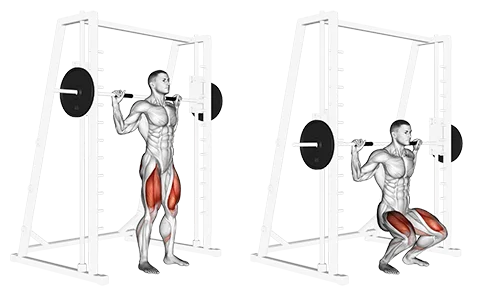Introduction
The Smith Machine Squat is a weight training exercise that utilizes a vertical bar guided by fixed steel tracks. This exercise primarily targets the quadriceps, hamstrings, and glutes while also improving lower body strength and stability. It's an effective choice for those who are new to weightlifting or seeking a controlled environment for learning proper squat form due to its guide mechanism. Its effectiveness lies in its ability to isolate specific muscle groups, making it beneficial for shaping and strengthening the lower body, particularly during fitness goals focused on muscular development and functional strength training.
Muscles Worked
- Primary: Quadriceps (front of thigh), Hamstrings (back of thigh)
- Secondary: Gluteus maximus (buttocks), Adductors (inner thigh), Erector spinae (lower back)
How to Do It (Step-by-Step)
- Stand facing the smith machine with feet shoulder-width apart and the barbell at arm's length.
- Position the barbell on your back by bending slightly at the hips and lowering your chest slightly forward. Use a grip that's just wider than shoulder-width.
- Keep your chest up, core tight, and head in a neutral position. Lower your hips slowly as if you were sitting in a chair until your thighs are parallel to the floor. Push through your heels to return to the starting position.
Tip: Engage your core throughout the movement to maintain proper form and protect your lower back.
Rep & Rest Guidelines
- Strength: 4–6 reps, 2–3 min rest
- Hypertrophy: 8–12 reps, 60–90 sec rest
- Endurance: 12–20 reps, 30–60 sec rest
Train smarter with Auto Progression. Optimize your rest periods using the Rest Timer.
Form Tips
- Maintain an upright torso with a slight natural arch in your lower back. Avoid rounding or over-arching your spine.
- Keep your feet shoulder-width apart, toes pointing slightly outwards, and press evenly through your heels during the squat.
- Make sure the barbell is directly above your heels and over the midfoot when standing upright to optimize balance and alignment.
When to Use It
- Rehabilitation and recovery from lower body injuries or surgeries
- Building leg strength in a controlled environment for beginners
- Targeting specific muscle groups in isolation for bodybuilding
- Keep track of your progress with Workout History
The Smith Machine provides a safer and more controlled environment compared to free weights, making it suitable for beginners or those rehabilitating injuries.
It helps maintain correct form and reduce the risk of injury. The fixed pathway reduces the need for core stabilization and balance.
Smith machine squats primarily work the quadriceps, hamstrings, glutes, and core. However, compared to free weight squats, they engage less stabilizer muscles.
Most machines have adjustable pins to change the barbell height. Set it so that when standing under the barbell, your feet are shoulder-width apart and the bar is at hip level.
Yes. Free weight squats engage more stabilizer muscles for balance and promote functional strength. However, the Smith Machine helps maintain correct form and reduce injury risk.

